Speed Analyses of Intersections Reconstructed into Roundabouts: A Case Study from Rijeka, Croatia
Abstract
1. Introduction
2. Roundabout Efficiency Analyses—A Literature Review
- Procedures for analyzing and comparing solutions in advance during the planning or design phase to determine whether a roundabout is an optimal solution compared to other types of at-grade intersections concerning the reason for the reconstruction of the intersection;
- Research that is carried out after the construction of roundabouts in which, based on the performance data, the impact of the roundabout’s implementation on safety, capacity, environment, etc., is analyzed and estimated.
2.1. Analyses of the Possible Effects of Roundabout Implementation in the Planning Stage
2.2. Analyses of Traffic Safety after the Implementation of a Roundabout
- Traffic parameters—the speed, volume, and structure of traffic flow in the narrower and wider zones of the intersection;
- Design parameters—the size of the outer radius, the radius of the central island, the width of circulatory road, the width and radius of the entry and exit, the entry angle, and deflection.
3. Materials and Methods
3.1. Selected Parameters
3.1.1. Traffic Parameters
- Operating speed;
- Time distribution of traffic load and speed.
3.1.2. Design Parameters
- The outer radius of the roundabout—Ro [m];
- Width of the circulatory road—u [m];
- Entry width—eent [m];
- Entry radius—Rent [m];
- Exit width—eex [m];
- Exit radius—Rex [m];
- Entrance angle—ɸ [°];
- Radius of the central island (including traversable apron)—Rc [m];
- Width of traversable apron—t [m];
- Deflection—d [m].
4. Data Analysis and Results
- Design elements;
- Operating speeds before and after intersection reconstruction;
- Correlations between traffic and speed data (operating speed and traffic load) and the selected roundabout design elements.
4.1. Analysis of Design Elements
4.2. Operating Speed before–after Analyses
- Daily operating speed or V85-24h;
- Operating speed during peak periods, V85-MPH (morning peak hour);
- Operating speed at night, V85-NP (night period).
- Daily operating speed;
- Operating speeds in the morning peak hour (MPH);
- Operating speeds in the night period (NP).
4.3. Correlation between Traffic and Design Elements
4.4. Summary of the Results
5. Conclusions
Author Contributions
Funding
Data Availability Statement
Acknowledgments
Conflicts of Interest
References
- Shirazi, M.S.; Morris, B.T. Looking at intersections: A survey of intersection monitoring, behavior and safety analysis of recent studies. IEEE Trans. Intell. Transp. Syst. 2016, 18, 4–24. [Google Scholar] [CrossRef]
- Liu, M.; Lu, G.; Wang, Y.; Wang, Y.; Zhang, Z. Preempt or yield? An analysis of driver’s dynamic decision making at unsignalized intersections by classification tree. Saf. Sci. 2014, 65, 36–44. [Google Scholar] [CrossRef]
- Pilko, H.; Brčić, D.; Šubić, N. Istraživanje brzine kretanja vozila pri projektiranju kružnih raskrižja. Građevinar 2014, 66, 407–416. [Google Scholar]
- Antov, D.; Abel, K.; Sürje, P.; Rõuk, H.; Rõivas, T. Speed reduction effects of urban roundabouts. Balt. J. Road Bridge Eng. 2009, 4, 22–26. [Google Scholar] [CrossRef]
- Deluka-Tibljaš, A.; Tollazzi, T.; Barišić, I.; Babić, S.; Šurdonja, S.; Renčelj, M.; Pranjić, I. Smjernice za Projektiranje Kružnih Raskrižja na Državnim Cestama; Građevinski fakultet Sveučilišta u Rijeci: Rijeka, Croatia, 2015. [Google Scholar]
- Ministarstvo Unutarnjih Poslova RH: Bilten o Sigurnosti Cestovnog Prometa 2014, 2016, 2018, 2020, 2021, 2022. Available online: https://mup.gov.hr/pristup-informacijama-16/statistika-228/statistika-mup-a-i-bilteni-o-sigurnosti-cestovnog-prometa/bilteni-o-sigurnosti-cestovnog-prometa/287330 (accessed on 15 November 2023). (In Croatian)
- Hydén, C.; Várhelyi, A. The effects on safety, time consumption and environment of large scale use of roundabouts in an urban area: A case study. Accid. Anal. Prev. 2000, 32, 11–23. [Google Scholar] [CrossRef] [PubMed]
- De Brabander, B.; Nuyts, E.; Vereeck, L. Road safety effects of roundabouts in Flanders. J. Saf. Res. 2005, 36, 289–296. [Google Scholar] [CrossRef] [PubMed]
- Kennedy, J.; Peirce, J.; Summersgill, I. Review of accident research at roundabouts. Transp. Res. Circ. 2005, 2005, 14. [Google Scholar]
- Kozić, M.; Šurdonja, S.; Deluka-Tibljaš, A.; Karleuša, B.; Cuculić, M. Criteria for urban traffic infrastructure analyses–case study of implementation of Croatian Guidelines for Rounabouts on State Roads. In Road and Rail Infrastructure IV; Faculty of Civil Engineering, University of Zagreb: Zagreb, Croatia, 2016. [Google Scholar]
- Ammanatidou, P.; Palantzas, G.; Nalmpantis, D. Selection between signalized traffic light junction and roundabout with the use of multi-criteria decision analysis (MCDA). In Proceedings of the International Conference on Environmental Design (ICED2020), Athens, Greece, 24–25 October 2020. [Google Scholar]
- Pilko, H.; Mandžuka, S.; Barić, D. Urban single-lane roundabouts: A new analytical approach using multi-criteria and simultaneous multi-objective optimization of geometry design, efficiency and safety. Transp. Res. Part C Emerg. Technol. 2017, 80, 257–271. [Google Scholar] [CrossRef]
- Bayrak, O.Ü.; Bayata, H.F. Multi-criteria decision-based safety evaluation using microsimulation. In Proceedings of the Institution of Civil Engineers-Transport; Thomas Telford Ltd.: London, UK, 2020; Volume 173, pp. 345–357. [Google Scholar]
- Numpaque, N.R.; Anselmi, L.M.; Polo, K.R.; Mendoza, C.G. Alternatives to improve operational traffic in roundabouts using microsimulation. Respuestas 2020, 25, 26–36. [Google Scholar]
- Kłos, M.; Sobota, A. Performance evaluation of roundabouts using a microscopic simulation model. Zesz. Nauk. Transp./Politech. Śląska 2019, 104, 57–67. [Google Scholar]
- Silva, A.B.; Mariano, P.; Silva, J.P. Performance assessment of turbo-roundabouts in corridors. Transp. Res. Procedia 2015, 10, 124–133. [Google Scholar] [CrossRef]
- Gastaldi, M.; Meneguzzer, C.; Rossi, R.; Della Lucia, L.; Gecchele, G. Evaluation of air pollution impacts of a signal control to roundabout conversion using microsimulation. Transp. Res. Procedia 2014, 3, 1031–1040. [Google Scholar] [CrossRef]
- Mądziel, M.; Campisi, T.; Jaworski, A.; Kuszewski, H.; Woś, P. Assessing vehicle emissions from a multi-lane to turbo roundabout conversion using a microsimulation tool. Energies 2021, 14, 4399. [Google Scholar] [CrossRef]
- Gruden, C.; Otković, I.I.; Šraml, M. Pedestrian behaviour and safety at roundabouts: A comparative study between real and microsimulation outcomes. In Proceedings of the Road safety and Digitalization, RSS 2022, Athens, Greece, 8–10 June 2020. [Google Scholar]
- Ambros, J.; Novák, J.; Borsos, A.; Hóz, E.; Kieć, M.; Machciník, Š.; Ondrejka, R. Central European comparative study of traffic safety on roundabouts. Transp. Res. Procedia 2016, 14, 4200–4208. [Google Scholar] [CrossRef]
- Persaud, B.N.; Retting, R.A.; Garder, P.E.; Lord, D. Crash reductions following installation of roundabouts in the United States. Insur. Inst. Highw. Saf. 2000, 15, 540–542. [Google Scholar]
- Gross, F.; Lyon, C.; Persaud, B.; Srinivasan, R. Safety effectiveness of converting signalized intersections to roundabouts. Accid. Anal. Prev. 2013, 50, 234–241. [Google Scholar] [CrossRef] [PubMed]
- Novak, J.; Ambros, J.; Frič, J. How Roundabout Entry design Parameters Influence Safety. Transp. Res. Rec. 2018, 2672, 73–84. [Google Scholar] [CrossRef]
- Maycock, G.; Hall, R.D. Accidents at 4-Arm Roundabouts; TRRL Laboratory Report LR. 1120; Transport and Road Research Laboratory: Crowthorne, UK, 1984. [Google Scholar]
- Arndt, O. Roundabout Safety Study: Effect of Geometry on Accident Rate; Transport Technology Division, Report DSB01; Queensland Department of Transport: Brisbane, Australia, 1991. [Google Scholar]
- Riccardi, M.R.; Augeri, M.G.; Galante, F.; Mauriello, F.; Nicolosi, V.; Montella, A. Safety Index for evaluation of urban roundabouts. Accid. Anal. Prev. 2022, 178, 106858. [Google Scholar] [CrossRef] [PubMed]
- Ott, R.L.; Longnecker, M. An Introduction to Statistical Methods and Data Analysis, 5th ed.; Duxbury: Pacific Grove, CA, USA, 2001. [Google Scholar]
- Montgomery, D.C. Applied Statistics and Probability for Engineers; John Wiley and Sons: Hoboken, NJ, USA, 2003. [Google Scholar]
- Bonett, D.G.; Seier, E. Confidence interval for a coefficient of dispersion in nonnormal distributions. Biom. J. 2006, 48, 144–148. [Google Scholar] [CrossRef] [PubMed]
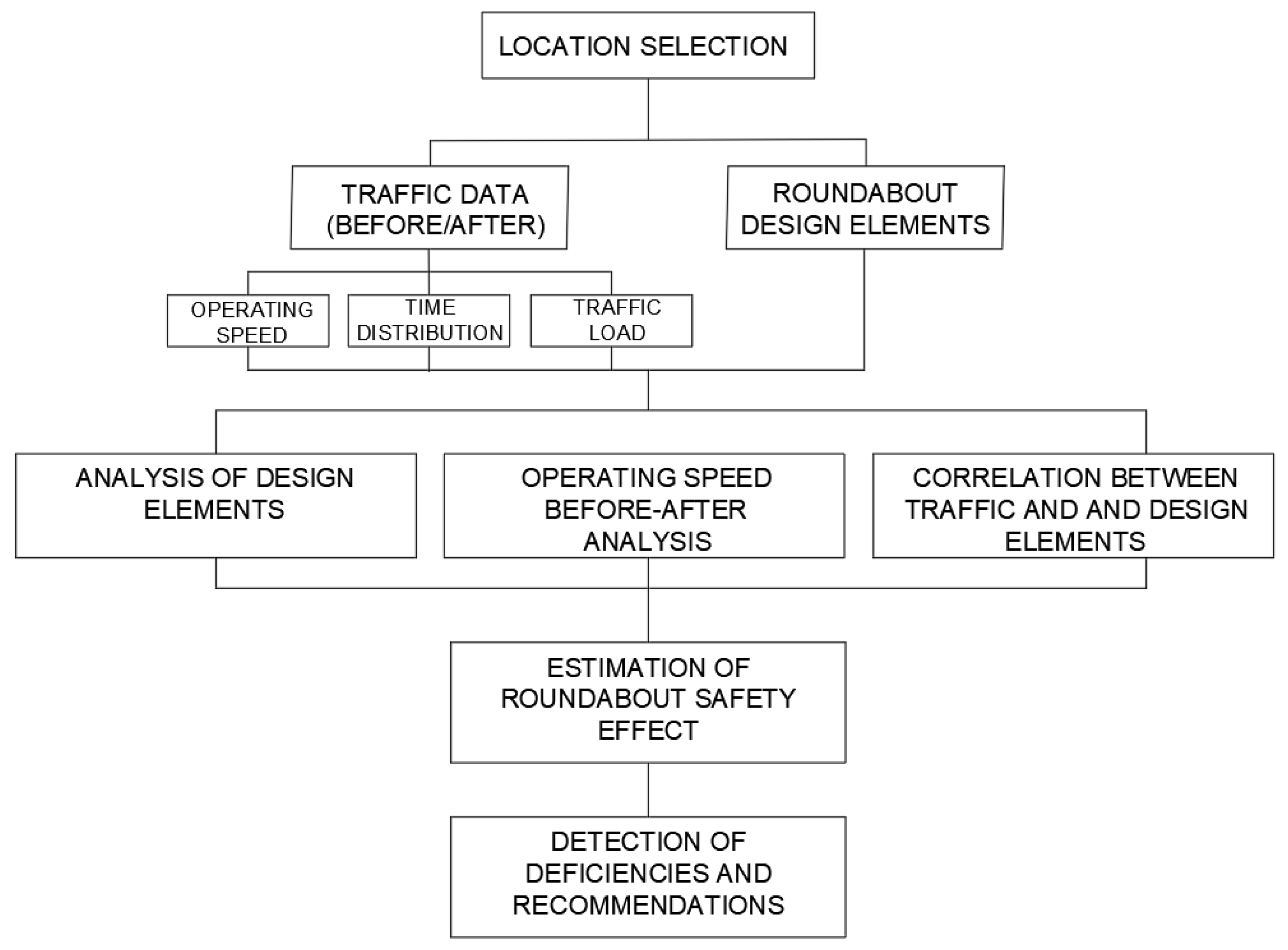


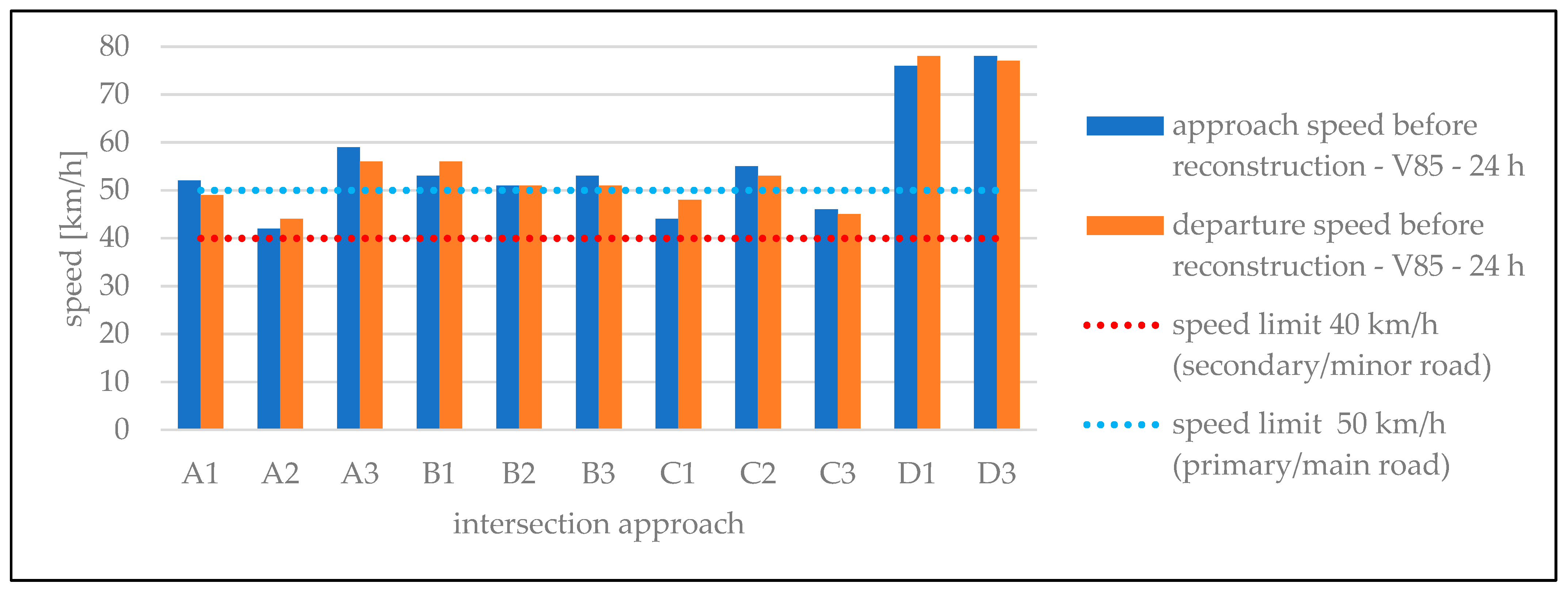
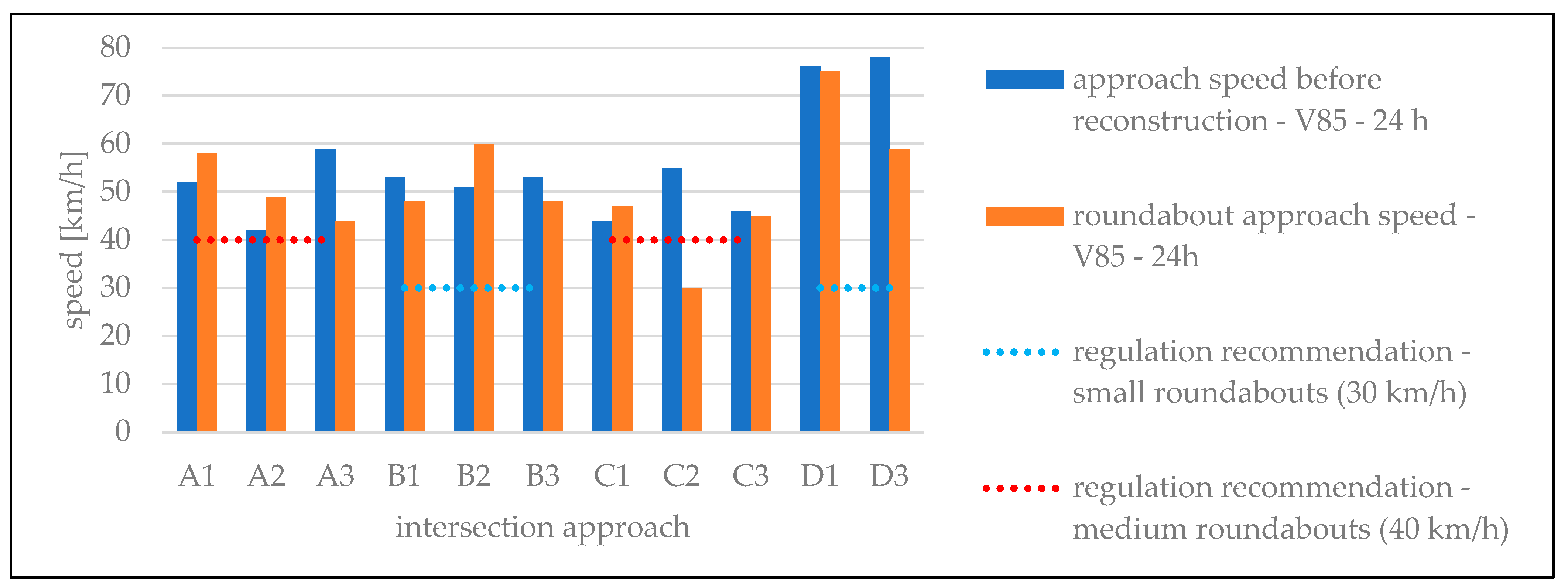
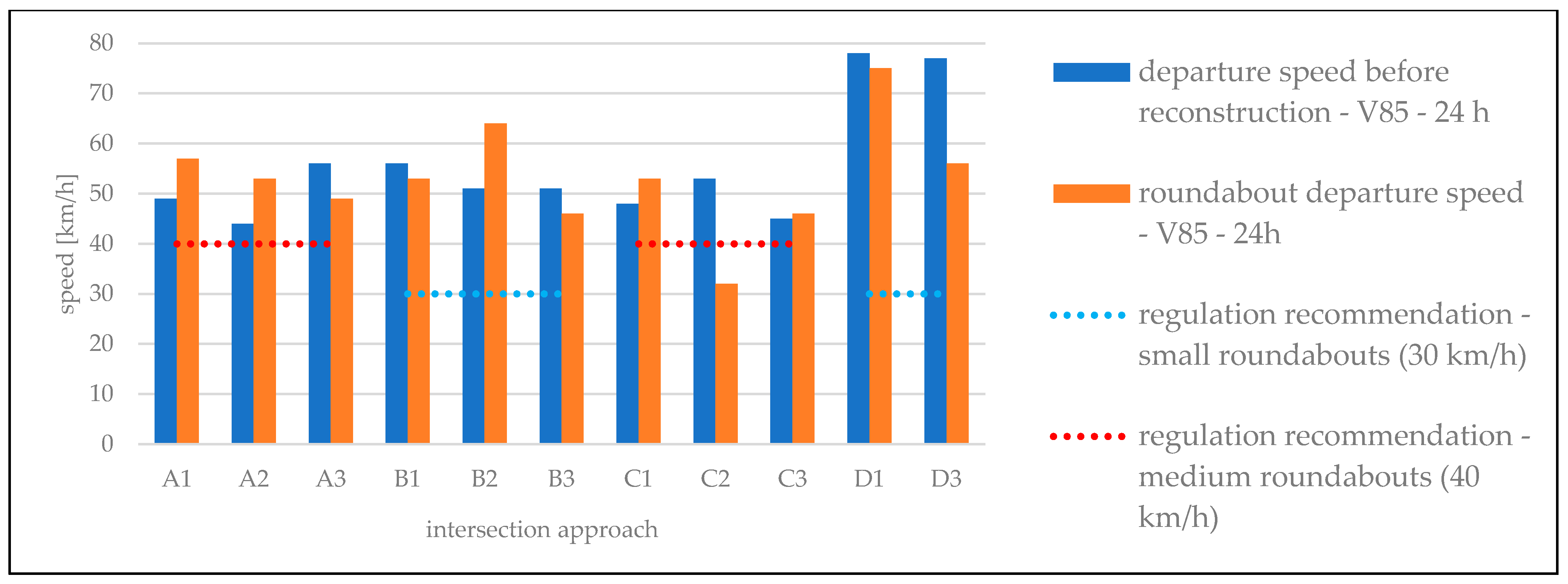
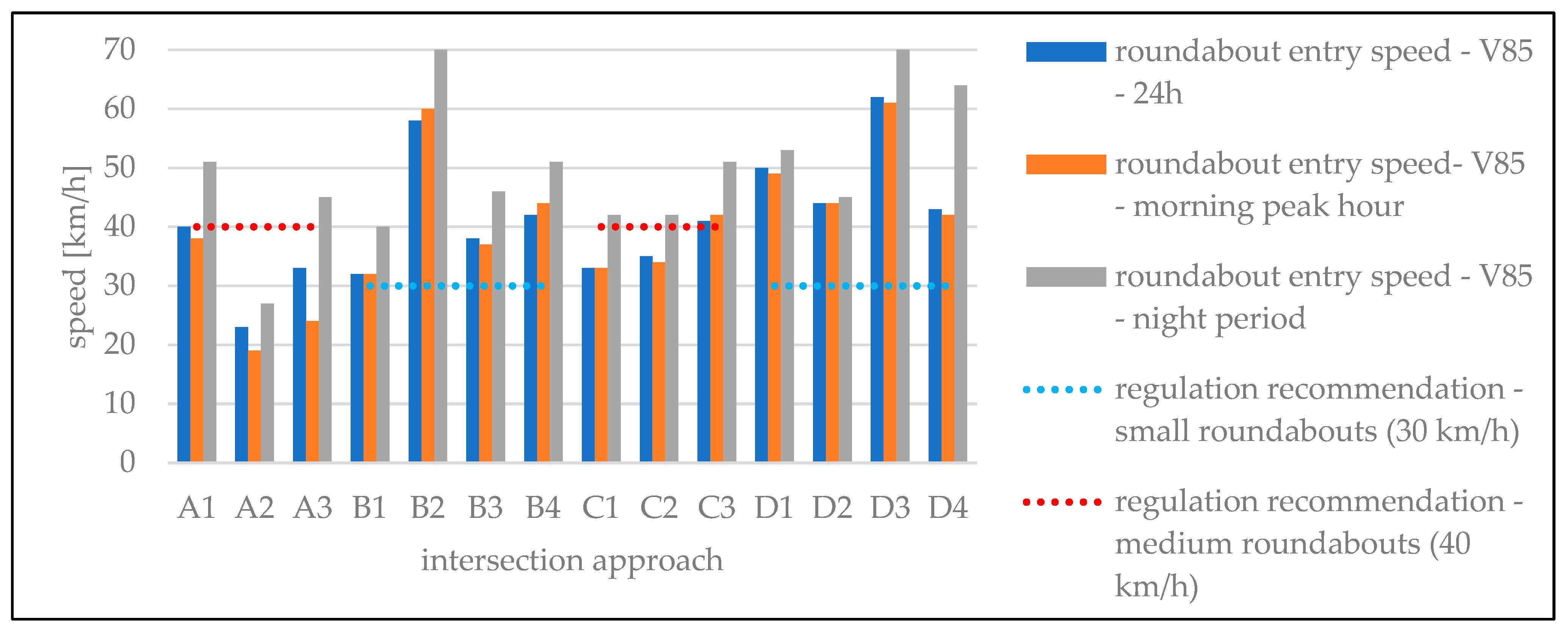
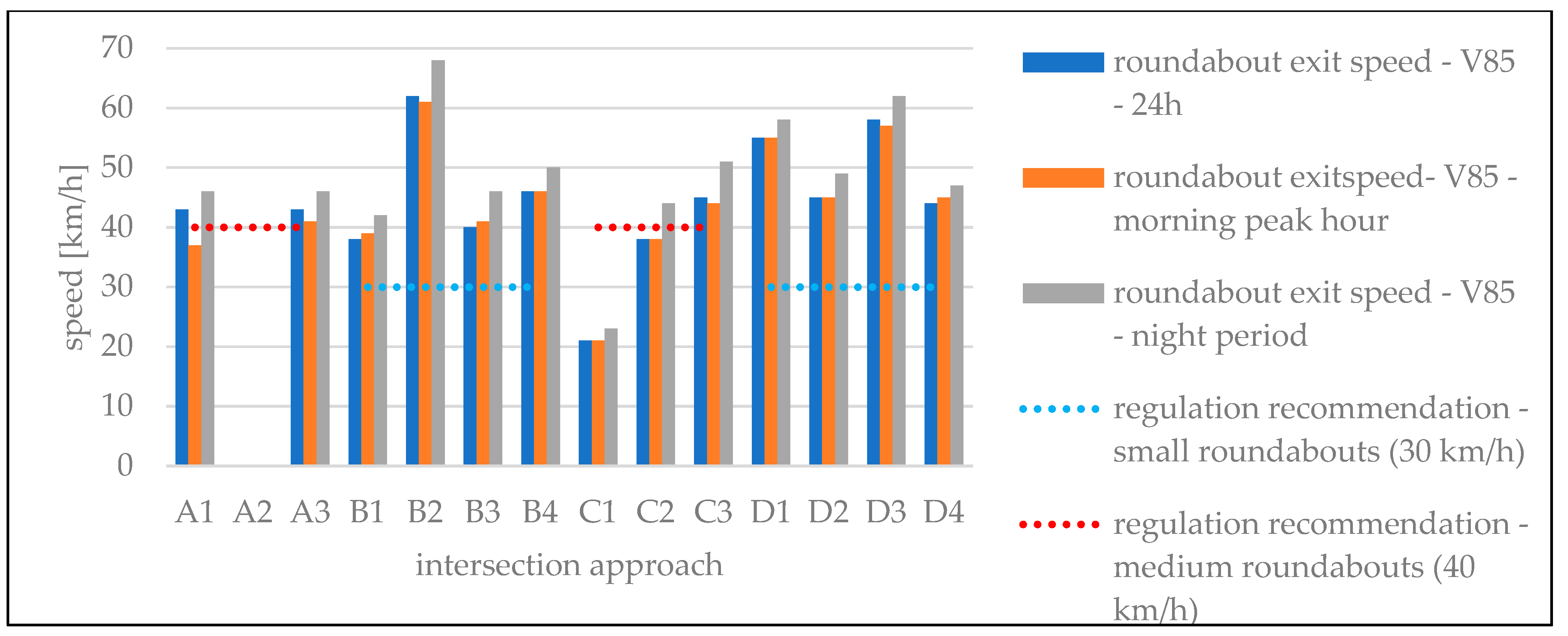

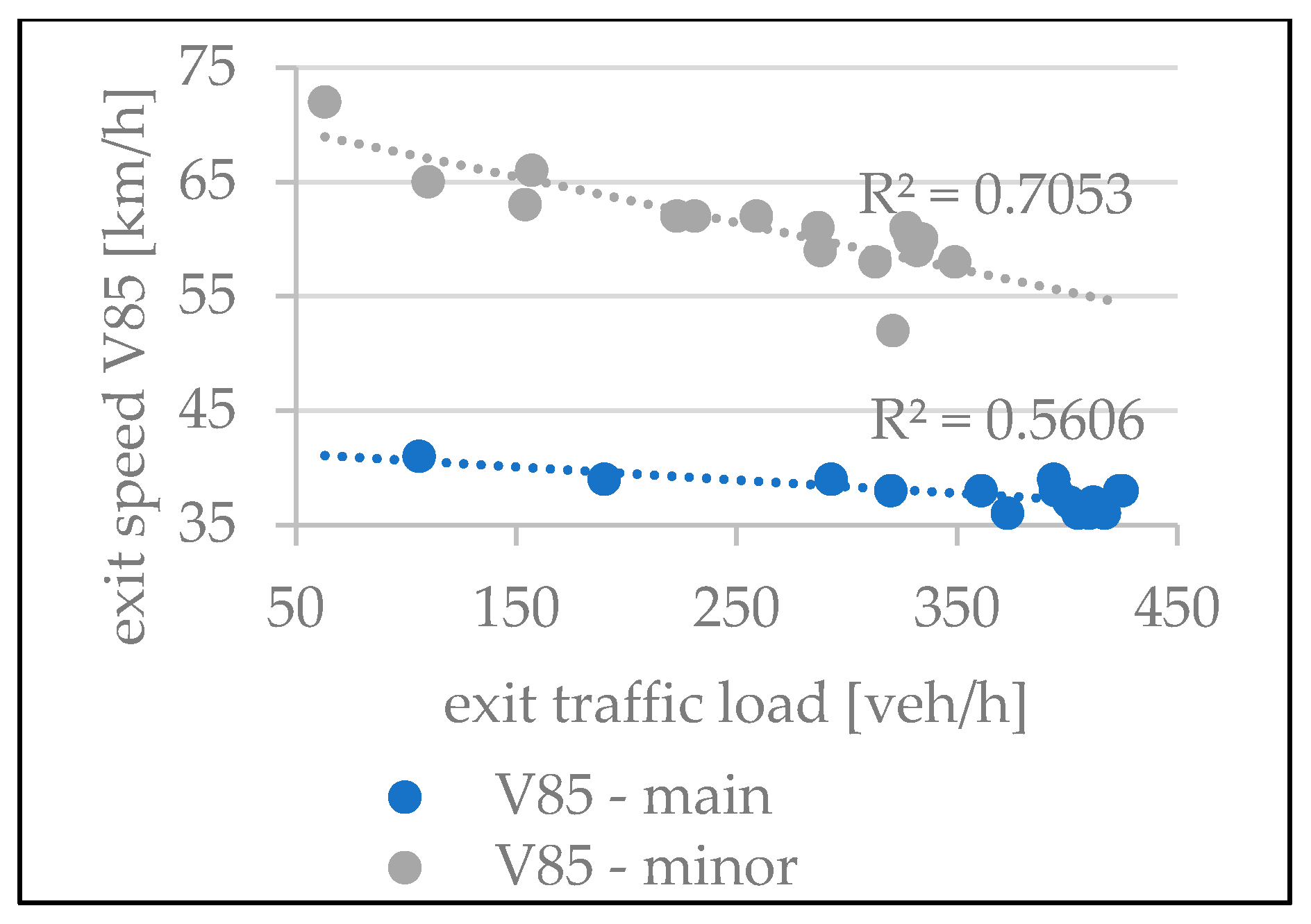


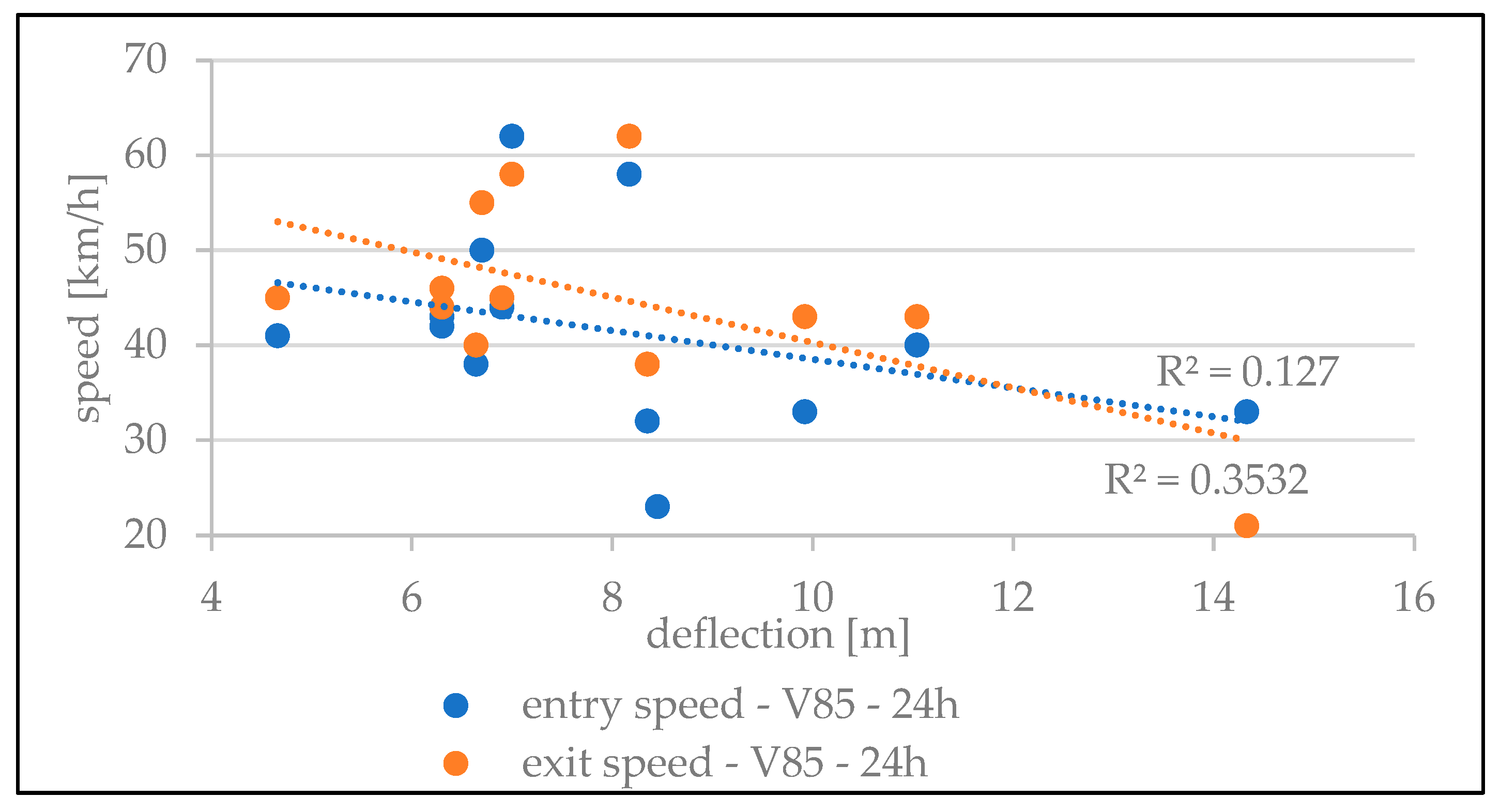
| Intersection A | Intersection B | Intersection C | Intersection D | Croatian Guidelines (Range of Applied Values) | |||||||||||
|---|---|---|---|---|---|---|---|---|---|---|---|---|---|---|---|
| A1 | A2 | A3 | B1 | B2 | B3 | B4 | C1 | C2 | C3 | D1 | D2 | D3 | D4 | ||
| Ro | 19 | 16 | 17.5 | 15 | 11–25 | ||||||||||
| u | 7 | 7 | 6.5 | 6.5 | 4–9 | ||||||||||
| eent | 5.8 | 5.6 | 6.4 | 5.8 | 5.2 | 4.5 | 5.4 | 5.6 | 6.2 | 5.5 | 5.2 | 5.6 | 5.6 | 4.7 | 3.6–10 |
| Rent | 15 | 22.3 | 15 | 14.6 | 14 | 14 | 15 | 17 | 19 | 16 | 12.5 | 12.6 | 18 | n/a | 6–25 |
| eex | 5.8 | 6.4 | 5.7 | 4.7 | 5.3 | 4.5 | 5.4 | 6.4 | 5.5 | 6 | 6.5 | 4.9 | 6.5 | 4.5 | 3.6–10 |
| Rex | 16 | 16 | 22.3 | 16 | 14.6 | 16 | 16 | 18 | 16 | 19 | n/a | 15 | 11.1 | 18.5 | 8–50 |
| ɸ | 41 | 33 | 44 | 42 | 39 | 33 | 38 | 40 | 41.5 | 40 | 42 | 22 | 38 | 46 | 0–77 |
| d | 11 | 8.5 | 9.9 | 8.4 | 8.2 | 6.6 | 6.3 | 14.3 | n/a | 4.7 | 6.7 | 6.9 | 7 | 6.3 | no recommendation |
| Rc | 12 | 12 | 12 | 9 | 9 | 9 | 9 | 11 | 11 | 11 | 8.5 | 8.5 | 8.5 | 8.5 | 7.5–18 |
| t | 2 | 2 | 2 | 1.5 | 1.5 | 1.5 | 1.5 | 2.5 | 2.5 | 2.5 | 2 | 2 | 2 | 2 | min 1 |
| Intersection A | Intersection B | Intersection C | Intersection D | ||||||||||||
|---|---|---|---|---|---|---|---|---|---|---|---|---|---|---|---|
| Approach | A1 | A2 | A3 | B1 | B2 | B3 | B4 | C1 | C2 | C3 | D1 | D2 | D3 | D4 | |
| before reconstruction | approach speed V85-24h | 52 | 42 | 59 | 53 | 51 | 53 | n/a | 44 | 55 | 46 | 76 | n/a | 78 | n/a |
| departure speed V85-24h | 49 | 44 | 56 | 56 | 51 | 51 | n/a | 48 | 53 | 45 | 78 | n/a | 77 | n/a | |
| roundabout | approach speed V85-24h | 58 | 49 | 44 | 48 | 60 | 48 | 54 | 47 | 30 | 45 | 75 | 36 | 59 | n/a |
| approach speed V85-MPH | 53 | 44 | 32 | 58 | 63 | 48 | 55 | 46 | 29 | 50 | 74 | 36 | 58 | n/a | |
| approach speed V85-NP | 67 | 54 | 52 | 48 | 74 | 60 | 66 | 65 | 35 | 52 | 77 | 41 | 66 | n/a | |
| departure speed V85-24h | 57 | 53 | 49 | 53 | 64 | 46 | 54 | 53 | 32 | 46 | 75 | 38 | 56 | n/a | |
| departure speed V85-MPH | 41 | 51 | 47 | 59 | 63 | 48 | 54 | 51 | 32 | 48 | 75 | 39 | 55 | n/a | |
| departure speed V85-NP | 63 | 52 | 54 | 54 | 72 | 59 | 59 | 65 | 36 | 53 | 85 | 43 | 62 | n/a | |
| entry speed V85-24h | 40 | 23 | 33 | 32 | 58 | 38 | 42 | 33 | 35 | 41 | 50 | 44 | 62 | 43 | |
| entry speed V85-MPH | 38 | 19 | 24 | 32 | 60 | 37 | 44 | 33 | 34 | 42 | 49 | 44 | 61 | 42 | |
| entry speed V85-NP | 51 | 27 | 45 | 40 | 70 | 46 | 51 | 42 | 42 | 51 | 53 | 45 | 70 | 64 | |
| exit speed V85-24h | 43 | n/a | 43 | 38 | 62 | 40 | 46 | 21 | 38 | 45 | 55 | 45 | 58 | 44 | |
| exit speed V85-MPH | 37 | n/a | 41 | 39 | 61 | 41 | 46 | 21 | 38 | 44 | 55 | 45 | 57 | 45 | |
| exit speed V85-NP | 46 | n/a | 46 | 42 | 68 | 46 | 50 | 23 | 44 | 51 | 58 | 49 | 62 | 47 | |
| Approach | Number of Observations | V85 | Vmin | Vmax | Vavg | Std. Deviation | Mann–Whitney | p-Value | |
|---|---|---|---|---|---|---|---|---|---|
| A1 | before reconstruction | 7904 | 52 | 8 | 78 | 45 | 7.6 | −22.110 | <0.001 |
| roundabout | 10,988 | 58 | 5 | 94 | 47 | 11.9 | |||
| A2 | before reconstruction | 6382 | 42 | 5 | 70 | 32 | 10.5 | −50.488 | <0.0001 |
| roundabout | 7725 | 49 | 6 | 87 | 41 | 8.9 | |||
| A3 | before reconstruction | 7451 | 59 | 21 | 85 | 52 | 6.9 | 99.279 | <0.0001 |
| roundabout | 9834 | 44 | 5 | 79 | 34 | 11.5 | |||
| B1 | before reconstruction | 11,242 | 53 | 6 | 98 | 45 | 8.7 | 36.642 | <0.0001 |
| roundabout | 6609 | 48 | 8 | 74 | 41 | 8.3 | |||
| B2 | before reconstruction | 3525 | 51 | 6 | 91 | 42 | 10.2 | −31.827 | <0.0001 |
| roundabout | 4085 | 60 | 6 | 106 | 50 | 10.9 | |||
| B3 | before reconstruction | 10,154 | 53 | 10 | 106 | 45 | 8.9 | 39.1514 | <0.0001 |
| roundabout | 7797 | 48 | 8 | 93 | 40 | 8.7 | |||
| C1 | before reconstruction | 10,363 | 44 | 7 | 101 | 35 | 10.0 | 10.569 | <0.0001 |
| roundabout | 6066 | 47 | 10 | 80 | 37 | 8.3 | |||
| C2 | before reconstruction | 3121 | 55 | 9 | 87 | 46 | 9.1 | 66.292 | <0.0001 |
| roundabout | 3525 | 30 | 5 | 41 | 24 | 6.3 | |||
| C3 | before reconstruction | 9142 | 46 | 6 | 89 | 38 | 8.3 | −16.036 | <0.0001 |
| roundabout | 5337 | 45 | 10 | 82 | 40 | 7.5 | |||
| D1 | before reconstruction | 4677 | 76 | 22 | 129 | 66 | 11.1 | 6.458 | <0.0001 |
| roundabout | 4605 | 75 | 14 | 117 | 65 | 10.9 | |||
| D3 | before reconstruction | 4040 | 78 | 37 | 120 | 69 | 9.2 | 68.780 | <0.0001 |
| roundabout | 4084 | 59 | 24 | 94 | 51 | 7.5 | |||
| Approach | Number of Observations | V85 | Vmin | Vmax | Vavg | Std. Deviation | Mann–Whitney | p-Value | |
|---|---|---|---|---|---|---|---|---|---|
| A1 | before reconstruction | 10,684 | 49 | 9 | 79 | 43 | 7.0 | −51.863 | <0.001 |
| roundabout | 8333 | 57 | 9 | 96 | 48 | 10.0 | |||
| A2 | before reconstruction | 3077 | 44 | 9 | 68 | 37 | 8.1 | −30.700 | <0.001 |
| roundabout | 2898 | 53 | 12 | 86 | 44 | 9.3 | |||
| A3 | before reconstruction | 8219 | 56 | 15 | 86 | 50 | 6.7 | 64.057 | <0.001 |
| roundabout | 8787 | 49 | 11 | 84 | 42 | 6.9 | |||
| B1 | before reconstruction | 7916 | 56 | 13 | 107 | 49 | 8.4 | 22.371 | <0.001 |
| roundabout | 6045 | 53 | 12 | 75 | 46 | 7.1 | |||
| B2 | before reconstruction | 4747 | 51 | 8 | 84 | 44 | 7.2 | −50.803 | <0.001 |
| roundabout | 4606 | 64 | 8 | 117 | 54 | 10.3 | |||
| B3 | before reconstruction | 10,828 | 51 | 7 | 102 | 43 | 9.2 | 35.054 | <0.001 |
| roundabout | 8024 | 46 | 7 | 91 | 39 | 7.0 | |||
| C1 | before reconstruction | 8600 | 48 | 8 | 93 | 39 | 9.4 | −23.361 | <0.001 |
| roundabout | 2045 | 53 | 15 | 87 | 45 | 8.3 | |||
| C2 | before reconstruction | 3460 | 53 | 9 | 86 | 44 | 9.6 | 60.530 | <0.001 |
| roundabout | 2905 | 32 | 4 | 49 | 27 | 4.9 | |||
| C3 | before reconstruction | 9101 | 45 | 6 | 89 | 37 | 9.9 | −32.439 | <0.001 |
| roundabout | 3746 | 46 | 7 | 85 | 43 | 7.1 | |||
| D1 | before reconstruction | 4074 | 78 | 9 | 119 | 69 | 9.9 | 14.476 | <0.0001 |
| roundabout | 3253 | 75 | 27 | 124 | 66 | 9.7 | |||
| D3 | before reconstruction | 4934 | 77 | 16 | 134 | 67 | 10.9 | 71.847 | <0.0001 |
| roundabout | 4675 | 56 | 16 | 81 | 49 | 7.4 | |||
Disclaimer/Publisher’s Note: The statements, opinions and data contained in all publications are solely those of the individual author(s) and contributor(s) and not of MDPI and/or the editor(s). MDPI and/or the editor(s) disclaim responsibility for any injury to people or property resulting from any ideas, methods, instructions or products referred to in the content. |
© 2024 by the authors. Licensee MDPI, Basel, Switzerland. This article is an open access article distributed under the terms and conditions of the Creative Commons Attribution (CC BY) license (https://creativecommons.org/licenses/by/4.0/).
Share and Cite
Šurdonja, S.; Maršanić, R.; Deluka-Tibljaš, A. Speed Analyses of Intersections Reconstructed into Roundabouts: A Case Study from Rijeka, Croatia. Infrastructures 2024, 9, 159. https://doi.org/10.3390/infrastructures9090159
Šurdonja S, Maršanić R, Deluka-Tibljaš A. Speed Analyses of Intersections Reconstructed into Roundabouts: A Case Study from Rijeka, Croatia. Infrastructures. 2024; 9(9):159. https://doi.org/10.3390/infrastructures9090159
Chicago/Turabian StyleŠurdonja, Sanja, Robert Maršanić, and Aleksandra Deluka-Tibljaš. 2024. "Speed Analyses of Intersections Reconstructed into Roundabouts: A Case Study from Rijeka, Croatia" Infrastructures 9, no. 9: 159. https://doi.org/10.3390/infrastructures9090159
APA StyleŠurdonja, S., Maršanić, R., & Deluka-Tibljaš, A. (2024). Speed Analyses of Intersections Reconstructed into Roundabouts: A Case Study from Rijeka, Croatia. Infrastructures, 9(9), 159. https://doi.org/10.3390/infrastructures9090159








